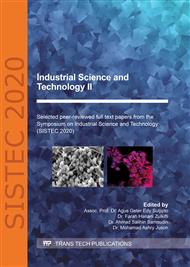[1]
J.W. Stansbury, M.J. Idacavage, 3D printing with polymers: Challenges among expanding options and opportunities, Dent. Mater. 32 (2016) 54–64.
DOI: 10.1016/j.dental.2015.09.018
Google Scholar
[2]
D. Mohan, N.F. Khairullah, Y.P. How, M.S. Sajab, H. Kaco, 3D Printed Laminated CaCO3-Nanocellulose Films as Controlled-Release 5-Fluorouracil, Polymers. 12 (2020) 986.
DOI: 10.3390/polym12040986
Google Scholar
[3]
G.L. Koons, A.G. Mikos, Progress in three-dimensional printing with growth factors, J. Control. Release. 295 (2019) 50–59.
DOI: 10.1016/j.jconrel.2018.12.035
Google Scholar
[4]
A. Malas, D. Isakov, K. Couling, G.J. Gibbons, Fabrication of high permittivity resin composite for vat photopolymerization 3D printing: Morphology, thermal, dynamic mechanical and dielectric properties, Materials. 12 (2019) 3818.
DOI: 10.3390/ma12233818
Google Scholar
[5]
H. Eng, J. Wei, Y.Y.C. Choong, S. Yu, C.L.C. Tan, P.C. Su, S. Maleksaeedi, F.E. Wiria, 3D Stereolithography of Polymer Composites Reinforced with Orientated Nanoclay, Procedia Eng. 216 (2018) 1–7.
DOI: 10.1016/j.proeng.2018.02.080
Google Scholar
[6]
Z. Weng, Y. Zhou, W. Lin, T. Senthil, L. Wu, Structure-property relationship of nano enhanced stereolithography resin for desktop SLA 3D printer, Compos. Part A Appl. Sci. Manuf. 88 (2016) 234–242.
DOI: 10.1016/j.compositesa.2016.05.035
Google Scholar
[7]
F. Ibrahim, D. Mohan, M.S. Sajab, S.B. Bakarudin, H. Kaco, Evaluation of the Compatibility of Organosolv Lignin-Graphene Nanoplatelets with Photo-Curable Polyurethane in Stereolithography 3D Printing, Polymers. 11 (2019) 1544.
DOI: 10.3390/polym11101544
Google Scholar
[8]
D. Mohan, M.S. Sajab, H. Kaco, S.B. Bakarudin, A.M. Noor, 3D Printing of Uv-Curable Polyurethane Incorporated With Surface-Grafted Nanocellulose, Nanomaterials. 9 (2019) 1–15.
DOI: 10.3390/nano9121726
Google Scholar
[9]
P. Cataldi, A. Athanassiou, I.S. Bayer, Graphene nanoplatelets-based advanced materials and recent progress in sustainable applications, Appl. Sci. 8 (2018) 1438.
DOI: 10.3390/app8091438
Google Scholar
[10]
J. Cha, J. Kim, S. Ryu, S.H. Hong, Comparison to mechanical properties of epoxy nanocomposites reinforced by functionalized carbon nanotubes and graphene nanoplatelets, Compos. Part B Eng. 162 (2019) 283–288.
DOI: 10.1016/j.compositesb.2018.11.011
Google Scholar
[11]
M. Rafiee, F. Nitzsche, J. Laliberte, S. Hind, F. Robitaille, M.R. Labrosse, Thermal properties of doubly reinforced fiberglass/epoxy composites with graphene nanoplatelets, graphene oxide and reduced-graphene oxide, Compos. Part B Eng. 164 (2019) 1–9.
DOI: 10.1016/j.compositesb.2018.11.051
Google Scholar
[12]
G. Spinelli, R. Kotsilkova, E. Ivanov, I. Petrova-Doycheva, D. Menseidov, V. Georgiev, R. Di Maio, C. Silvestre, Effects of filament extrusion, 3D printing and hot-pressing on electrical and tensile properties of poly(Lactic) acid composites filled with carbon nanotubes and graphene, Nanomaterials. 10 (2020) 35.
DOI: 10.3390/nano10010035
Google Scholar
[13]
E. Ivanov, R. Kotsilkova, H. Xia, Y. Chen, R.K. Donato, K. Donato, A.P. Godoy, R. Di Maio, C. Silvestre, S. Cimmino, V. Angelov, PLA/Graphene/MWCNT composites with improved electrical and thermal properties suitable for FDM 3D printing applications, Appl. Sci. 9 (2019) 1209.
DOI: 10.3390/app9061209
Google Scholar
[14]
D. Mohan, Z.K. Teong, A.N. Bakir, M.S. Sajab, H. Kaco, Extending Cellulose-Based Polymers Application in Additive Manufacturing Technology: A Review of Recent Approaches, Polymers. 12 (2020) 1876.
DOI: 10.3390/polym12091876
Google Scholar
[15]
K.T. Teo, A. Hassan, S.N. Gan, UV-Curable urethane acrylate resin from palm fatty acid distillate, Polymers. 10 (2018) 1374.
DOI: 10.3390/polym10121374
Google Scholar
[16]
J.-L. Phua, P.-L. Teh, S.A. Ghani, C.-K. Yeoh, Effect of Heat Assisted Bath Sonication on the Mechanical and Thermal Deformation Behaviours of Graphene Nanoplatelets Filled Epoxy Polymer Composites, Int. J. Polym. Sci. 133 (2016) 1-8.
DOI: 10.1155/2016/9767183
Google Scholar
[17]
M.M. Shokrieh, M.R. Hosseinkhani, M.R. Naimi-Jamal, H. Tourani, Nanoindentation and nanoscratch investigations on graphene-based nanocomposites, Polym. Test. 32 (2013) 45–51.
DOI: 10.1016/j.polymertesting.2012.09.001
Google Scholar
[18]
M.M. Ghobashy, Z.I. Abdeen, Radiation Crosslinking of Polyurethanes: Characterization by FTIR, TGA, SEM, XRD, and Raman Spectroscopy, J. Polym. 2016 (2016) 1–9.
DOI: 10.1155/2016/9802514
Google Scholar
[19]
D. Kunwong, N. Sumanochitraporn, S. Kaewpirom, Curing behavior of a UV-curable coating based on urethane acrylate oligomer: The influence of reactive monomers. J. Sci. Technol. 33 (2011) 201–207.
DOI: 10.1007/s10965-012-9995-1
Google Scholar


